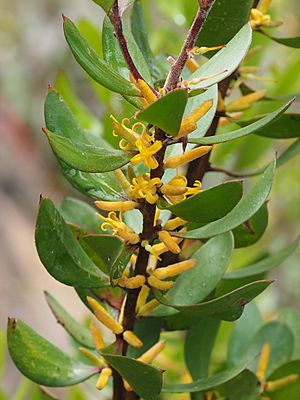Persoonia oleoides facts for kids
Quick facts for kids Persoonia oleoides |
|
|---|---|
 |
|
| Scientific classification | |
| Genus: |
Persoonia
|
| Species: |
oleoides
|
| Synonyms | |
|
Persoonia oxycoccoides var. longifolia Benth. |
|
The Persoonia oleoides is a special kind of flowering plant. It belongs to the Proteaceae family, which includes many unique Australian plants. This plant is only found in one specific area: the north-eastern part of New South Wales in Australia. This means it is endemic to that region.
This plant is usually a shrub that stands upright or sometimes grows low to the ground. It has leaves that are shaped like long ovals or eggs. Its flowers are yellow and grow in groups.
Contents
What Does Persoonia Oleoides Look Like?
The Persoonia oleoides is a shrub that can grow from about 20 centimeters (8 inches) to 1 meter (3 feet) tall. Its bark is smooth. When the branches are young, they are covered with soft, greyish or rust-colored hairs.
Its leaves grow one after another along the stem. They are usually shaped like an oblong, an ellipse, an egg, or a spatula. These leaves are about 2 to 6 centimeters (0.8 to 2.4 inches) long and 0.4 to 1.5 centimeters (0.16 to 0.6 inches) wide.
Flowers and Fruit
The yellow flowers of Persoonia oleoides grow in different ways. Sometimes they appear where a leaf joins the stem. Other times, they grow at the ends of branches.
Some flower groups have up to three flowers on a short stem, about 1 centimeter (0.4 inches) long. Other groups can have up to twenty-five flowers on a longer stem, up to 13 centimeters (5 inches) long. Each flower sits on a tiny stalk called a pedicel, which is only 1 to 3 millimeters long. The flower parts, called tepals, are yellow and hairy. They are about 1 to 1.5 centimeters (0.4 to 0.6 inches) long.
This plant usually flowers in January and February. After flowering, it produces a green fruit. This fruit is called a drupe, which is a fleshy fruit with a hard pit inside, like a peach. Sometimes, these green fruits have purple stripes.
How Was Persoonia Oleoides Named?
Scientists officially described Persoonia oleoides for the first time in 1991. Two botanists, Lawrie Johnson and Peter Weston, gave it its scientific name. They published their description in a scientific journal called Telopea.
Where Does Persoonia Oleoides Grow?
This type of geebung (another name for plants in the Persoonia genus) lives in forests. You can find it in eastern New South Wales, Australia. It grows in the areas between the upper parts of the Clarence River, the upper Macleay River, and a place called Barrington Tops.


